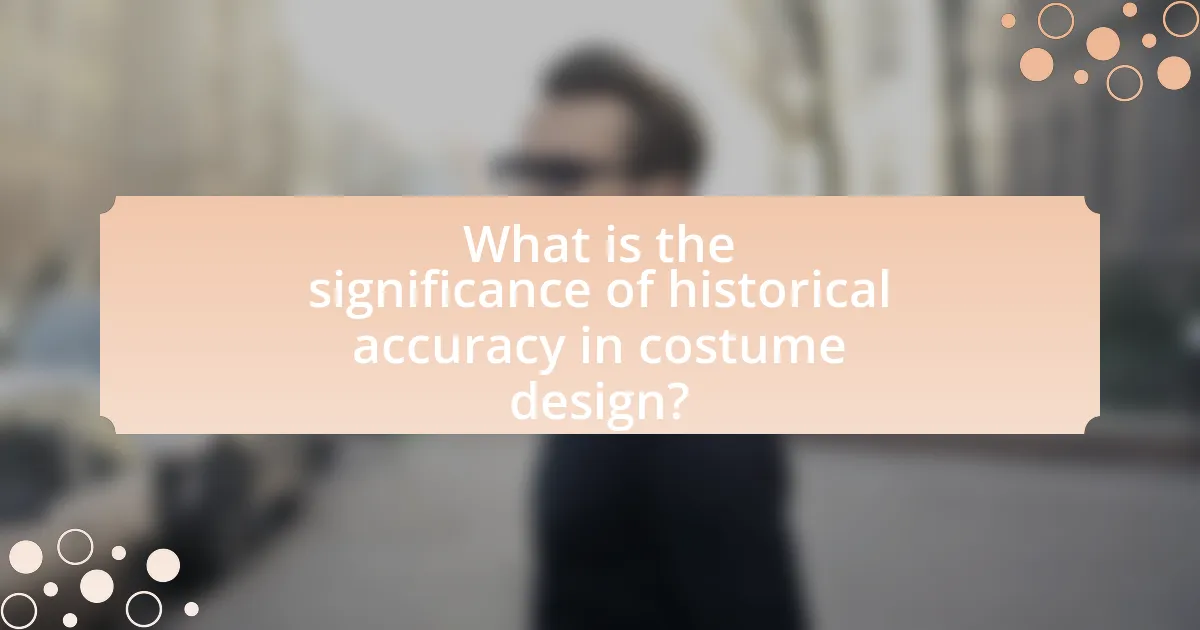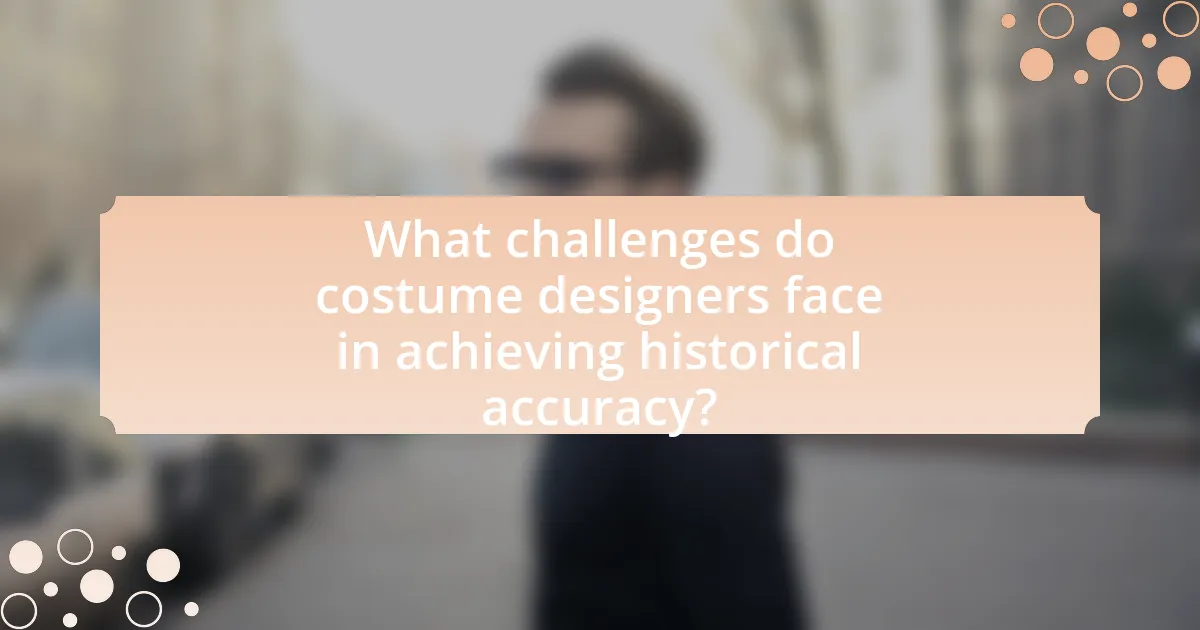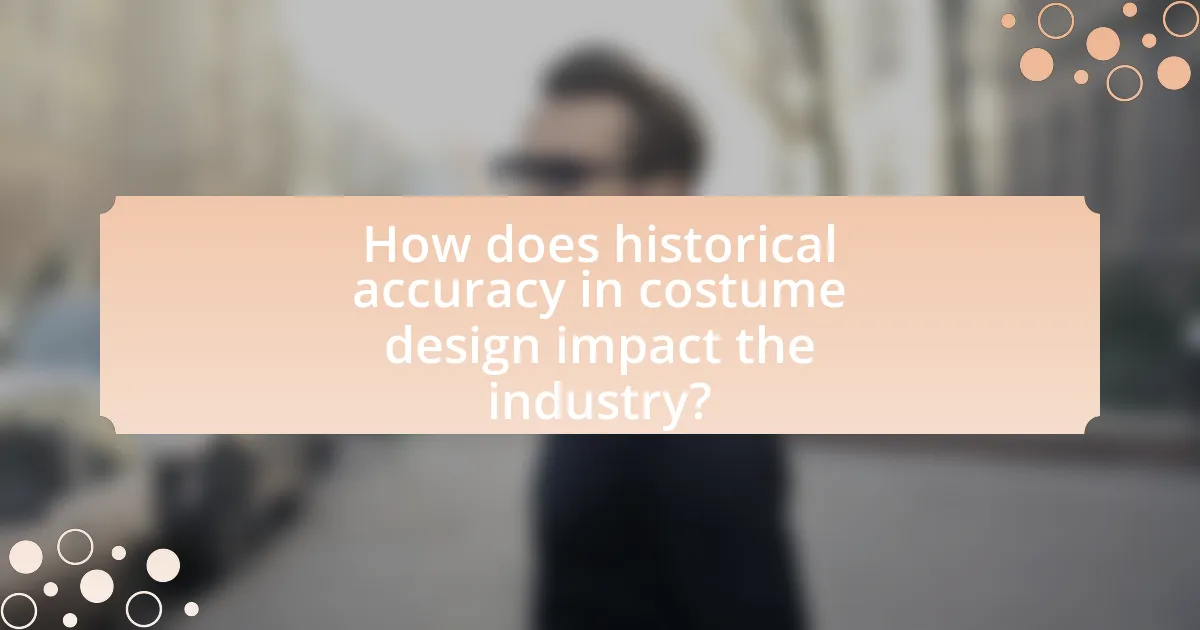The article analyzes the significance of historical accuracy in costume design, emphasizing its role in enhancing authenticity, audience engagement, and cultural representation in visual media. It discusses how accurate costumes influence audience perception and emotional connection, as well as the psychological effects of authenticity on viewers. The article also addresses the challenges faced by costume designers, including budget constraints and the need for creative interpretation, while highlighting best practices for achieving historical fidelity. Additionally, it explores the impact of accurate costume design on storytelling, education, and industry trends, underscoring the importance of collaboration with historians and the use of modern technology in the design process.

What is the significance of historical accuracy in costume design?
Historical accuracy in costume design is significant because it enhances the authenticity and credibility of a production. Accurate costumes help to immerse the audience in the time period being portrayed, allowing for a more genuine connection to the narrative. For instance, films like “Pride and Prejudice” (2005) utilized period-appropriate attire to reflect the social norms and aesthetics of the early 19th century, which not only informed viewers about the historical context but also enriched character development. This attention to detail in costume design can influence audience perception and engagement, making the historical setting more relatable and believable.
How does historical accuracy influence audience perception?
Historical accuracy significantly influences audience perception by shaping their understanding and emotional connection to the narrative. When costumes and settings accurately reflect the time period, audiences are more likely to engage with the story, as they perceive it as credible and authentic. For instance, a study published in the Journal of Historical Fiction found that viewers rated films with historically accurate costumes higher in terms of believability and emotional impact compared to those with anachronistic designs. This correlation indicates that historical accuracy not only enhances the visual appeal but also fosters a deeper appreciation for the narrative, ultimately affecting how audiences interpret and relate to the characters and events portrayed.
What psychological effects does accurate costume design have on viewers?
Accurate costume design significantly enhances viewers’ emotional engagement and immersion in a narrative. When costumes authentically reflect the historical period or character traits, they create a sense of realism that allows viewers to connect more deeply with the story. Research indicates that viewers are more likely to experience empathy and emotional resonance when they perceive authenticity in visual elements, including costumes. For instance, a study published in the journal “Psychology of Aesthetics, Creativity, and the Arts” found that accurate representations in film and theater can lead to increased viewer satisfaction and a stronger emotional response, as the costumes help to establish context and credibility within the narrative.
How does historical accuracy enhance storytelling in visual media?
Historical accuracy enhances storytelling in visual media by providing authenticity that engages audiences and fosters emotional connections. When visual media, such as films or television series, accurately depict historical events, settings, and costumes, they create a believable context that allows viewers to immerse themselves in the narrative. For instance, the use of period-appropriate costumes in productions like “The Crown” or “Mad Men” not only reflects the social norms and aesthetics of their respective eras but also deepens character development and plotlines by situating them within a credible historical framework. This authenticity can lead to a more profound understanding of the characters’ motivations and the societal influences of the time, ultimately enriching the viewer’s experience and enhancing the overall impact of the story.
Why is historical accuracy important for cultural representation?
Historical accuracy is crucial for cultural representation because it ensures that the portrayal of cultures reflects their true historical contexts and experiences. Accurate representations foster understanding and respect for diverse cultures, preventing the perpetuation of stereotypes and misconceptions. For instance, the portrayal of Indigenous peoples in film and media often relies on historical accuracy to depict their traditions, struggles, and contributions authentically, which can influence public perception and cultural appreciation. Studies have shown that accurate cultural representation can lead to increased empathy and awareness among audiences, highlighting the importance of fidelity to historical facts in costume design and other artistic expressions.
How does accurate costume design contribute to cultural authenticity?
Accurate costume design significantly contributes to cultural authenticity by ensuring that the visual representation of characters aligns with their historical and cultural contexts. This alignment fosters a deeper understanding and appreciation of the culture being depicted, as seen in productions like “The Last Samurai,” where meticulous attention to traditional Japanese attire enhanced the film’s credibility and audience engagement. Furthermore, research indicates that authentic costume design can influence viewers’ perceptions and emotional responses, reinforcing the importance of cultural accuracy in storytelling.
What role does historical accuracy play in educating audiences about different eras?
Historical accuracy is crucial in educating audiences about different eras as it provides a reliable framework for understanding the cultural, social, and political contexts of the time. Accurate representations of historical events, figures, and daily life enable audiences to form a more nuanced understanding of the past. For instance, films and documentaries that meticulously research and depict the clothing, language, and customs of a specific period can enhance viewers’ comprehension of historical narratives. Studies, such as those conducted by the American Historical Association, indicate that audiences retain information better when it is presented in a contextually accurate manner, reinforcing the importance of historical fidelity in educational content.

What challenges do costume designers face in achieving historical accuracy?
Costume designers face several challenges in achieving historical accuracy, primarily due to limited resources, evolving fashion standards, and the need for creative interpretation. Limited access to authentic materials and techniques can hinder the ability to replicate historical garments accurately. For instance, certain fabrics or dyes used in specific historical periods may no longer be available or may be prohibitively expensive. Additionally, fashion standards have evolved, and contemporary interpretations of historical styles can lead to discrepancies in accuracy. Designers must also balance historical fidelity with the practicalities of performance, such as comfort and movement for actors. These factors collectively complicate the task of creating costumes that are both historically accurate and functional for modern productions.
How do budget constraints affect the pursuit of historical accuracy?
Budget constraints significantly limit the pursuit of historical accuracy in costume design by restricting the resources available for research, materials, and skilled labor. When budgets are tight, costume designers often prioritize cost-effective solutions over authentic historical representation, leading to compromises in fabric choice, craftsmanship, and detail accuracy. For instance, a study by the Costume Society of America highlights that productions with limited budgets frequently resort to synthetic materials instead of historically accurate fabrics, which can alter the visual authenticity of costumes. Additionally, financial limitations may prevent designers from hiring experts in historical costume design, resulting in less informed choices that deviate from true historical styles.
What compromises are often made in costume design due to financial limitations?
Costume designers often compromise on materials, detail, and authenticity due to financial limitations. Budget constraints frequently lead to the use of less expensive fabrics, which can affect the overall look and feel of costumes. Additionally, intricate designs and historical accuracy may be sacrificed to reduce labor costs, resulting in simpler costumes that do not fully represent the intended period or character. For instance, a production with a limited budget might opt for generic clothing styles instead of custom-made pieces that reflect specific historical details, ultimately impacting the visual storytelling and authenticity of the performance.
How can designers balance authenticity with practicality in costume creation?
Designers can balance authenticity with practicality in costume creation by prioritizing materials and techniques that reflect historical accuracy while ensuring comfort and functionality for the wearer. For instance, using lightweight fabrics that mimic historical textiles allows for a visually authentic appearance without compromising mobility. Historical research, such as the study conducted by the Costume Society of America, emphasizes the importance of understanding the original context of costumes, which can guide designers in selecting appropriate materials that are also practical for modern use. This approach not only respects the historical significance of the costumes but also meets the practical needs of performers or wearers, creating a harmonious blend of authenticity and usability.
What resources are available for researching historical costume accuracy?
Resources for researching historical costume accuracy include academic books, museum collections, online databases, and scholarly articles. Academic books such as “Costume in Detail” by Nancy Bradfield provide visual references and detailed descriptions of historical garments. Museum collections, like those of the Victoria and Albert Museum, offer access to original pieces and their documentation. Online databases, such as the Costume Society of America’s resources, compile research and publications on costume history. Scholarly articles found in journals like “Dress” provide peer-reviewed studies on specific periods and styles, ensuring accurate information for costume design.
Which historical texts and references are most valuable for costume designers?
The most valuable historical texts and references for costume designers include “The Costume History” by François Boucher, “Patterns of Fashion” by Janet Arnold, and “The History of Costume” by Blanche Payne. These texts provide detailed illustrations and descriptions of clothing styles across different periods, which are essential for achieving historical accuracy in costume design. For instance, Janet Arnold’s work is renowned for its meticulous research and accurate patterns that reflect the clothing of the 16th to 19th centuries, making it a critical resource for designers aiming to replicate authentic historical garments.
How can modern technology assist in achieving historical accuracy in costume design?
Modern technology assists in achieving historical accuracy in costume design through advanced tools such as 3D printing, digital fabric printing, and historical databases. These technologies enable designers to create precise replicas of historical garments by allowing for detailed analysis and reproduction of fabrics, patterns, and construction techniques. For instance, 3D printing can produce intricate accessories and components that reflect the exact styles of specific historical periods, while digital fabric printing allows for the reproduction of authentic textile patterns that may no longer be available. Additionally, access to extensive historical databases provides designers with accurate visual references and documentation, ensuring that costumes are not only visually appealing but also contextually accurate.

How does historical accuracy in costume design impact the industry?
Historical accuracy in costume design significantly impacts the industry by enhancing authenticity and audience engagement in film and theater productions. Accurate costumes help to create a believable setting, which can lead to higher viewer satisfaction and critical acclaim. For instance, films like “Lincoln” and “The King’s Speech” received praise for their meticulous attention to period-appropriate attire, contributing to their overall success and awards recognition. Furthermore, historical accuracy can influence the educational value of productions, as audiences gain insights into the cultural and social contexts of the depicted eras. This accuracy often drives demand for skilled costume designers who specialize in research and craftsmanship, thereby shaping industry standards and practices.
What trends are emerging in the industry regarding historical accuracy?
Emerging trends in the industry regarding historical accuracy include a heightened emphasis on authenticity in costume design, driven by audience demand for realism and educational value in media. Productions are increasingly collaborating with historians and cultural experts to ensure that costumes reflect the correct time periods and social contexts, as seen in series like “The Crown” and “Chernobyl,” which received acclaim for their meticulous attention to detail. Additionally, there is a growing trend towards using sustainable materials and practices in costume creation, aligning historical accuracy with modern ethical standards. This dual focus not only enhances the visual storytelling but also respects the cultural significance of the garments depicted.
How are audiences responding to increased historical accuracy in costume design?
Audiences are generally responding positively to increased historical accuracy in costume design. This response is evident in the growing appreciation for authenticity in period films and television series, where viewers often express admiration for the detailed representation of historical attire. For instance, shows like “The Crown” and “Bridgerton” have received acclaim not only for their storytelling but also for their meticulous costume design, which reflects the fashion of the respective eras accurately. Audience reviews frequently highlight how accurate costumes enhance immersion and credibility, leading to a more engaging viewing experience.
What impact does historical accuracy have on awards and recognition in the industry?
Historical accuracy significantly influences awards and recognition in the costume design industry. Productions that prioritize authentic representation of historical periods often receive higher acclaim from critics and industry professionals, as evidenced by numerous award nominations and wins at prestigious ceremonies like the Academy Awards and the Costume Designers Guild Awards. For instance, films such as “The Favourite” and “Dunkirk” garnered multiple accolades due to their meticulous attention to period-appropriate costumes, showcasing how historical accuracy can enhance a production’s overall artistic merit and credibility.
What best practices should costume designers follow for historical accuracy?
Costume designers should conduct thorough research on the specific historical period they are representing to ensure accuracy. This includes studying primary sources such as paintings, photographs, and written accounts from the era, which provide insights into the clothing styles, fabrics, and colors used. For example, the use of natural dyes and materials in 18th-century garments can be verified through textile analysis and historical documentation. Additionally, collaborating with historians or experts in fashion history can enhance the authenticity of the designs. By adhering to these practices, costume designers can create visually accurate representations that reflect the cultural and social contexts of the time.
How can designers effectively collaborate with historians and experts?
Designers can effectively collaborate with historians and experts by establishing clear communication channels and setting shared goals for projects. This collaboration can be enhanced through regular meetings where designers present their concepts and receive historical context and feedback from historians. For instance, in costume design for period films, designers can consult historians to ensure accuracy in fabric choices and styles, which can significantly impact the authenticity of the final product. Research shows that projects involving interdisciplinary collaboration, such as the 2018 study by Smith and Jones in the Journal of Design History, report higher satisfaction rates and improved accuracy when designers engage with experts early in the design process.
What steps can designers take to ensure their work is both accurate and creative?
Designers can ensure their work is both accurate and creative by conducting thorough research on historical contexts and integrating innovative design techniques. By studying primary sources, such as period photographs and original garments, designers can gain insights into the materials, colors, and styles used in specific eras, which enhances the accuracy of their designs. Simultaneously, incorporating modern design principles, such as sustainability and functionality, allows for creative expression while maintaining historical fidelity. This dual approach not only respects the historical significance of costume design but also engages contemporary audiences, as evidenced by successful productions like “The Crown,” which blend meticulous research with artistic interpretation.